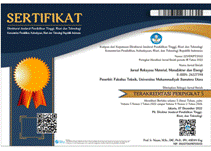Analisis Kekasaran Permukaan Cast Iron Menggunakan Cairan Pendingin Berbasis Nabati Pada Proses Face milling
Abstract
The machining process is a major activity in the industry, especially in the automotive industry. The machining process is inseparable from the coolant (coolant), where the role of the coolant in the machining process is to act as cool working conditions, material cleaning, and corrosion prevention. The use of cutting fluid has a negative impact when waste management is not carried out properly, and it will be damaging to the environment and public health. In order to reduce environmental and health damage, development and research have now been carried out for the use of vegetable-based cutting fluid. cutting fluid vegetable-based are biodegradable, eco-friendly, odorless, and non-toxic. This study wants to compare the value of surface roughness using CO (coconut oil) and dromus in face milling machining. The machine used in this research is the conventional Emco F3 milling machine and the tools used are the TPKN 22VC2 series carbide insert tools and the workpiece material used is cast iron (gray cast iron). the value of surface roughness by measuring the roughness using the TR200 surface roughness tool. The results of roughness observations show that the surface roughness value using CO cutting fluid at a cutting speed of 60 mm/min is 1,297 Ra, at a cutting speed of 70 mm/min the roughness value is 0.877 Ra and at a cutting speed of 80 mm/min, it is 0.429 Ra. While the results of measuring surface roughness on the material using a coolant dromus, cutting speed of 60 mm/min are 0.811 Ra, at a cutting speed of 70 mm/min the surface roughness value is 0.804 and at a cutting speed of 80 mm/min the surface roughness value is 0.698 Ra. So can the conclusion be that cutting fluid CO is good to use as a coolant at high cutting speeds.
Keywords
Full Text:
PDFReferences
S. Debnath, M. M. Reddy, and Q. S. Yi, Environmental friendly cutting fluids and cooling techniques in machining: a review, J. Clean. Prod., vol. 83, pp. 3347, 2014, doi: https://doi.org/10.1016/j.jclepro.2014.07.071.
K. K. Gajrani, P. S. Suvin, S. V. Kailas, K. P. Rajurkar, and M. R. Sankar, Machining of hard materials using textured tool with minimum quantity nano-green cutting fluid, CIRP J. Manuf. Sci. Technol., vol. 35, pp. 410421, 2021, doi: https://doi.org/10.1016/j.cirpj.2021.06.018.
A. R. Nasution, Affandi., and Z. Fuadi, Pengaruh Cairan Pendingin Terhadap Kekasaran Permukaan Benda Kerja Pada Proses Face Milling, J. Rekayasa Mater. Manufaktur dan Energi, vol. 3, no. 1, pp. 1622, 2019, doi: doi.org/10.30596/rmme.v3i1.4524.
A. Baumann, E. Oezkaya, D. Schnabel, D. Biermann, and P. Eberhard, Cutting-fluid flow with chip evacuation during deep-hole drilling with twist drills, Eur. J. Mech. B/Fluids, vol. 89, pp. 473484, 2021, doi: 10.1016/j.euromechflu.2021.07.003.
R. Teti, D. M. DAddona, and T. Segreto, Reprint of: Microbial-based cutting fluids as bio-integration manufacturing solution for green and sustainable machining, CIRP J. Manuf. Sci. Technol., 2021, doi: https://doi.org/10.1016/j.cirpj.2021.06.007.
J. A. Ghani, M. Rizal, and C. H. Che Haron, Performance of green machining: a comparative study of turning ductile cast iron FCD700, J. Clean. Prod., vol. 85, pp. 289292, 2014, doi: https://doi.org/10.1016/j.jclepro.2014.02.029.
A. R. Nasution, Z. Fuadi, I. Hasanuddin, and R. Kurniawan, Effect of vegetable oils as cutting fluid on wear of carbide cutting tool insert in a milling process, IOP Conf. Ser. Mater. Sci. Eng., vol. 796, no. 1, pp. 010, 2020, doi: 10.1088/1757-899X/796/1/012001.
K. K. Gajrani, P. S. Suvin, S. V. Kailas, and M. R. Sankar, Hard machining performance of indigenously developed green cutting fluid using flood cooling and minimum quantity cutting fluid, J. Clean. Prod., vol. 206, pp. 108123, 2019, doi: 10.1016/j.jclepro.2018.09.178.
A. Susanto, C. H. Liu, K. Yamada, Y. R. Hwang, R. Tanaka, and K. Sekiya, Milling process monitoring based on vibration analysis using hilbert-huang transform, Int. J. Autom. Technol., vol. 12, no. 5, pp. 688698, 2018, doi: 10.20965/ijat.2018.p0688.
A. R. Nasution, R. Rahmatullah, and J. Harahap, Pengaruh Variasi Putaran Spindel Terhadap Gaya Potong Pada Proses Pemesinan, VOCATECH Vocat. Educ. Technol. J.,
S. Debnath, M. M. Reddy, and Q. S. Yi, Environmental friendly cutting fluids and cooling techniques in machining: a review, J. Clean. Prod., vol. 83, pp. 3347, 2014, doi: https://doi.org/10.1016/j.jclepro.2014.07.071.
K. K. Gajrani, P. S. Suvin, S. V. Kailas, K. P. Rajurkar, and M. R. Sankar, Machining of hard materials using textured tool with minimum quantity nano-green cutting fluid, CIRP J. Manuf. Sci. Technol., vol. 35, pp. 410421, 2021, doi: https://doi.org/10.1016/j.cirpj.2021.06.018.
A. R. Nasution, Affandi., and Z. Fuadi, Pengaruh Cairan Pendingin Terhadap Kekasaran Permukaan Benda Kerja Pada Proses Face Milling, J. Rekayasa Mater. Manufaktur dan Energi, vol. 3, no. 1, pp. 1622, 2019, doi: doi.org/10.30596/rmme.v3i1.4524.
A. Baumann, E. Oezkaya, D. Schnabel, D. Biermann, and P. Eberhard, Cutting-fluid flow with chip evacuation during deep-hole drilling with twist drills, Eur. J. Mech. B/Fluids, vol. 89, pp. 473484, 2021, doi: 10.1016/j.euromechflu.2021.07.003.
R. Teti, D. M. DAddona, and T. Segreto, Reprint of: Microbial-based cutting fluids as bio-integration manufacturing solution for green and sustainable machining, CIRP J. Manuf. Sci. Technol., 2021, doi: https://doi.org/10.1016/j.cirpj.2021.06.007.
J. A. Ghani, M. Rizal, and C. H. Che Haron, Performance of green machining: a comparative study of turning ductile cast iron FCD700, J. Clean. Prod., vol. 85, pp. 289292, 2014, doi: https://doi.org/10.1016/j.jclepro.2014.02.029.
A. R. Nasution, Z. Fuadi, I. Hasanuddin, and R. Kurniawan, Effect of vegetable oils as cutting fluid on wear of carbide cutting tool insert in a milling process, IOP Conf. Ser. Mater. Sci. Eng., vol. 796, no. 1, pp. 010, 2020, doi: 10.1088/1757-899X/796/1/012001.
K. K. Gajrani, P. S. Suvin, S. V. Kailas, and M. R. Sankar, Hard machining performance of indigenously developed green cutting fluid using flood cooling and minimum quantity cutting fluid, J. Clean. Prod., vol. 206, pp. 108123, 2019, doi: 10.1016/j.jclepro.2018.09.178.
A. Susanto, C. H. Liu, K. Yamada, Y. R. Hwang, R. Tanaka, and K. Sekiya, Milling process monitoring based on vibration analysis using hilbert-huang transform, Int. J. Autom. Technol., vol. 12, no. 5, pp. 688698, 2018, doi: 10.20965/ijat.2018.p0688.
A. R. Nasution, R. Rahmatullah, and J. Harahap, Pengaruh Variasi Putaran Spindel Terhadap Gaya Potong Pada Proses Pemesinan, VOCATECH Vocat. Educ. Technol. J., vol. 2, no. 2, pp. 9299, 2021, doi: 10.38038/vocatech.v2i2.56.
R. Sankaranarayanan, R. J. H. N., S. K. J., and G. M. Krolczyk, A comprehensive review on research developments of vegetable-oil based cutting fluids for sustainable machining challenges, J. Manuf. Process., vol. 67, no. November 2020, pp. 286313, 2021, doi:
]Siregar, A. M., & Nasution, J. F. (2018). Efek Kecepatan Pembebanan Pada Bahan Baja Terhadap Kekuatan Tarik Impak. MEKANIK: Jurnal Ilmiah Teknik Mesin, 4(1).
DOI: https://doi.org/10.30596/rmme.v4i2.8073
Refbacks
- There are currently no refbacks.

This work is licensed under a Creative Commons Attribution 3.0 License
Jurnal Rekayasa Material, Manufaktur dan Energi is abstracting & indexing in the following databases:
This work is licensed under a Creative Commons Attribution-ShareAlike 4.0 International License.
Statcounter View My Stats RMME














